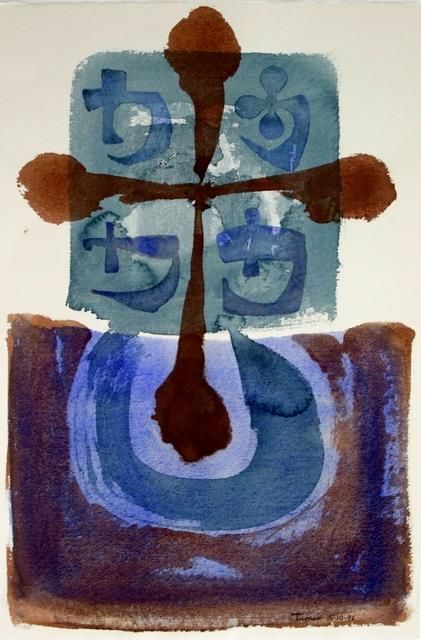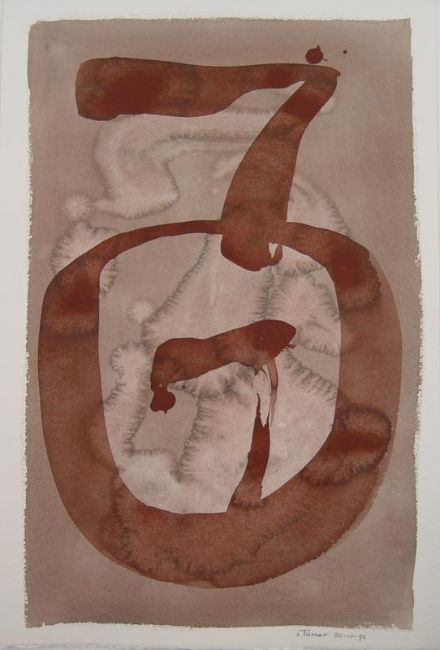Dennis Knight Turner
For background on the artist and works, see below.
Current Works
About the Artist
Born in 1924 in Whanganui, Dennis Knight Turner (d. 2010) was one of the first European artists to incorporate Maori and Oceanic motifs, for which he is recognised as one of New Zealand’s pioneering modernists. He was dismayed that local art in the 1940s and 1950s seemed very old-fashioned in its imitation of English regionalism. Along with his fellow artists Theo Schoon and Gordon Walters (famous for his Koru series), Turner was fascinated by the power and simple lines of Maori rock art and Oceanic art forms, and used these as a starting point for a new kind of distinctively Pacific modernism. He also liked the way these art forms could represent a human feature or form with a single line or block of colour.
Turner was described by the NZ Herald in 1951 as ‘providing the link between past and future that New Zealand has been needing’. He left New Zealand in 1964 to live in England, despondent at how hard it was to work here as a full-time career artist. He was persuaded to return to his home town of Whanganui for The Sarjeant public gallery Tylee Cottage residency in 1992, and completed a significant number of watercolour paintings, often using restrained colours mimicking natural pigments. These were first exhibited at The Diversion Gallery in Marlborough; some have been selected for a retrospective exhibition toured by the Auckland University Gus Fisher Gallery in 2014.
Although Dennis Knight Turner was regarded in the 1950s as one of Auckland’s most important artists, he came in and out of public favour over the years, a situation common to many artists who spent much of their career overseas, not exhibiting in New Zealand. However, recent articles and books now firmly acknowledge his significance in our art history.
Recent Works
The striking abstract watercolours from his Tylee Cottage residency were inspired by Melanesian and Oceanic motifs, in their swirls and sweeping forms.
These paintings are not reproductions of Oceanic forms, they are evolutions which respect the artistic quality of the original motifs which inspired him. As individual works, they have a strong impact, and a freshness which belies the fact they were painted over 20 years ago.
Each of the works is in perfect original condition, and we have a selection framed and unframed. This is an excellent opportunity for collectors to acquire quality work by an important artist, at very good value, accessible even for new collectors. Not all images are shown; please enquire to view the other paintings in the Oceanic series.
More About the Artist
The exhibition Oceania: The Sarjeant paintings arrived at The Diversion Gallery in Marlborough with a tale of mystery, about the apparent disappearance of the artist. In 2008 Luit Bieringa, former director of the National Art Gallery, asked if The Diversion would be interested in exhibiting a series of stunning modernist watercolours by important mid-20th Century New Zealand artist Dennis Knight Turner. The works had a strong appeal, still as fresh as when they were painted in 1992 when Turner was artist in residence in Whanganui.
Dennis Knight Turner was located in Hackney, London by arts writer Richard Wolfe, who interviewed him for Art New Zealand magazine and through this connection the exhibition went ahead in early 2010. Sadly, the artist died not long after the conclusion of that exhibition, but in the knowledge of a warm response to his work by a new generation of collectors.
Dennis Knight Turner was also known for his portraits in the 1940s and 1950s, and paintings of shearers and woolshed workers. Determined to make a living by his art practice without having to teach art, he worked at times as a commercial artist – including illustrating the School Journal and notably being prosecuted for painting a mural on a Sunday in breach of labour laws.
Ultimately he was dismayed New Zealand could not yet support full-time career artists, and left in 1964 for the UK. There, he continued his practice of visiting museums wherever he travelled, and making drawings of the Oceanic and Pacific art forms, inspiring new interpretations in his work.
Please contact us to confirm current prices: most prices are posted at the time of exhibition, and may be revised as the artists' values increase.








